#janet douglas lady glamis
Text
The proof in this trial [of Janet Douglas, Lady Glamis on 17 July 1537] is also awanting on record; but a version of the address which the lady is said to have delivered in her own defence is given by some writers as follows:-
“Those who hate the merit of my brother are enraged because he is not in their power, that he might fall a sacrifice to their malice, and they now discharge their spite upon me because of my near relation to him; and, to gratify their revenge with my blood, they accused me of crimes, which, if true, deserved the severest death. But, seeing it is the only prerogative of God to punish men or women for the faults of others, which belongs to no Judge on earth, who are obliged to punish ever one according in their personal crimes, you ought not to punish in me the actions of my brother, how blameable soever. Above all, you ought to consider if those things I am accused of have the least appearance of truth imaginable; for what gives the greatest evidence either of guilt or innocence of an impeached person is their former life. What fault could any hitherto lay to my charge? Did any ever reproach me with anything that is scandalous? Examine, I entreat you, my former conversation; vice hath its degree as well as virtue, and none can attain to a perfection in either, except by long use and practice; and if you can find nothing reprovable in my conduct, how can ye believe that I am arrived all of a sudden to contrive this murder, which is the very height and perfection of impiety? I protest I would not deliberately injure the most despicable wretch alive. Could I then make the murder of my Sovereign, whom I always reverenced, and who never did me any wrong, the first essay of my wickedness? None are capable of such damnable unnatural actions, except two sorts of persons – those of desperate fortunes who are weary of their lives, or those who are hurried into them by revenge. My birth and manner of life put me beyond suspicion of the first kind; and for the latter, seeing I was never injured by the King, how can I be suspected to thirst for any revenge? I am here accused for purposing to kill the King, and to make my pretended crime appear more frightful, it is given out that the way was to be by poison. With what impudence can any accuse me of such wickedness, who never saw any poison, nor know I anything about the preparation of it? Can any say they ever saw me have any of it? Let them tell me where I bought it, or who procured it me. And though I had it, how could I use it, seeing I never came near the King’s person, his table, nor palace? It is well known that since my last marriage with this unfortunate gentleman I had lived in the country at a great distance from the Court. What opportunity could I have, then, to poison the King? “You may see by those circumstances, which give great light in such matters, that I am entirely innocent of those crimes I am charged with. It is the office of you, Judges, to protect injured innocence. But if the malice and power of my enemies be such that, whether innocent or guilty I must needs be condemned, I shall die cheerfully, having the testimony of a good conscience. And assure yourselves that you shall certainly find it more easy to take away my life than to blast my reputation, or to fix any real blot upon my memory. “This is my last desire of you, that I may be the sole object of your severity, and that those other innocent persons may not share in my misfortunes. Seeing that my chief crime is that I am descended of the family of Douglas, there is no reason that they should be involved in my ruin; for my husband, son, and cousin were neither of that name nor family. I shall end my life with more comfort if you absolve them; for the more of us that suffer by your unjust sentence, the greater will be your guilt, and the more terrible your condemnation when you shall be tried at the great day by God, who is the impartial Judge of all flesh, who shall then make you suffer for those torments to which we are unjustly condemned.”
This speech is probably apocryphal, though Lady Glamis may have spoken somewhat in this strain. All defence, however, proved unavailing. Drummond of Hawthornden says that, before a verdict was given, “some of the Judges would have referred her to the King’s clemency till a farther trial of the witnesses might be had, upon whose testimony the process did depend, it being a safer way in judgment to absolve the guilty than condemn the innocent. But the most part gave her over to the Assizers, the better part of which being in voices fewer, the greater, who neither respecting conscience within them, nor shamed with the present age and posterity, nor the supreme justice of Heaven, find this poor lady guilty.” The French authority states that now two of the Judges repaired to the King’s presence and entreated for delay, but he, counselled by the accuser, William Lyon, gave an absolute refusal, telling them that the law must take its course, And so it did. The lady being found guilty of the “treasonable crimes” in the two points of her dittay, sentence was pronounced that she “has forfaulted to our Sovereign Lord her life, her lands, goods moveable and unmoveable; and that she shall be had to the Castlehill of Edinburgh, and there burned in a fire to death as a traitor.” And this the Doomster (the common executioner), as was the custom of the Court, laying his hands on her head, “gave for doom.” We may note that there was no exceptional barbarity in this sentence of burning alive, it being the legal practice in Scotland that women convicted of the higher crimes were burned at the stake, and for lesser offences drowned.
The sentence was carried out on the same day, and the lady was conducted from the bar to the pyre of faggots on the hill without much pause. “A little time after the sentence,” says the French writer, “she was delivered into the hands of the executioner, to be led out to suffer. The constancy and courage of this heroine are almost incredible, which astonished all the spectators. She heard the sentence pronounced against her without the least sign of concern, neither did she cry, groan, or shed a tear, though that kind of death is most frightful to human nature. When she was brought out to suffer, the people who looked on could not conceal their grief and compassion. Some of them who were acquainted with her, and knew her innocence, designed to rescue her; but the presence of the King and his Ministers” – it should be, the presence of the King’s Guards – “restrained them. She seemed to be the only unconcerned person there, and her beauty and charms never appeared with greater advantage than when she was led to the flames; and her soul being fortified with support from Heaven, and the sense of her own innocence, she outbraved death, and her courage was equal in the fire to what it was before her judges. She suffered those torments without the least noise: only she prayed devoutly for Divine assistance to support her under her sufferings. Thus died this famous lady, with a courage not inferior to that of any of the heroes of antiquity.”
— ‘Heroines of Scotland’ by R. S. Fittis (1889)
#this is a long read but thought it was worth sharing#historicalquotes#historical quotes#janet douglas#lady glamis#janet douglas lady glamis#n: janet douglas lady glamis#james v#house of douglas#scottish history#history#16th century#early modern history#*quotes
16 notes
·
View notes
Text
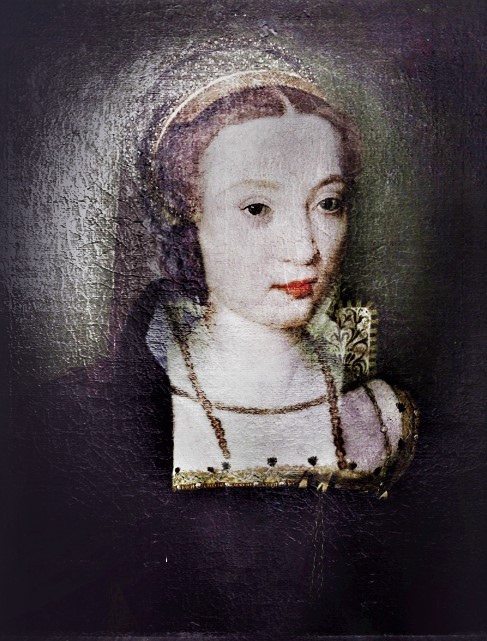
#Janet Douglas Lyon#Lady Glamis#Witchhunters#Odd Scotland#Scotland#history#witch trials#1537#Burned as a Witch#Past Times#Never Forget
2 notes
·
View notes
Text
TL;DR - anyone here like research essays? On Specific Fuckin Shit?
Okay so I was, earlier, putting my foot down and looking into the nitty gritty of how to format artwork (specifically in my case, traditional pieces) for print - which I have been putting off for years, and which is increasingly pertinent since as it stands it looks like drawing commissions and me do NOT get along well.
Aaaand then the wee devil on my shoulder told me that hey, hey, wouldn't it be more fun and gratifying for one of my specific old faves, to redraw it instead???
So basically now I'm fighting for my life in the historical clothing rabbit hole.
AND now wondering whether anyone would be interested hearing like, mini-essays slash rambling drabbles about what I turn up? God fucking knows that the content mill doesn't wait for man nor bird, and frankly I have my best ideas from when I see something and run around mental looking for More Info.
This would either be in like, common or garden tumblr post text format. Orrrrr... well we do love a good video essay, and apparently I have a "nice" "voice".
(Today, for example, we have - haunted locations in Scotland, ghosts of Edinburgh and Stirling castles, Lady Janet Douglas of Glamis (pronounced Glams because anglicizing Celtic languages works so so well all of the time), and courtly and medieval dress of Scotland)
#artblr#historical clothing#research essays#scottish history#fashion history#dress history#folklore#scottish folklore#british folklore#(hiding this tag from my mum)#(she's oan that SCOTTISH NOT BRITISH wagon)#(which to be fair so am I but we must commit to the bit)#ghost lore#folklore studies#amateur folklorist#man alive how to tag this for visibility#video essay
2 notes
·
View notes
Photo

Lady Janet Douglas
Died: 1537
Manner of Death: Burned at the Stake, Scotland.
Lady Janet Douglas was married to the 6th Lord of Glamis. It was a very advantageous marriage, and by all reports, also a very happy one. They had one son, John, and lived peacefully and in contentment until 1528, when Lord Glamis passed away. As was the way with well bred women in those days, Lady Janet married a second time, to a second son known as Archibald Campbell. Not much is known about their marriage.
King James V had a bone to pick with Lady Janet and all because the deep hatred he held for his step-father who had held him captive in order to claim ruler ship and he was Lady Janet’s brother. She was fair game for the vindictive King and if James couldn’t get revenge on Archibald Douglas, he’d get it on his sister instead.
James set to work on Janet’s downfall with a passion. He accused Lady Janet of making potions of ill intent with which to assassinate him, by the use of witchcraft. In doing so, he confiscated Glamis Castle in the name of the Crown and decided to live there. Lady Janet, her husband and her 16 year old son John were thrown in the dark and dank dudgeon’s of Edinburgh Castle. On a side note, Archibald, Janet’s husband is said to have escaped the castle, but was later killed.
Nobody believed for a second that Lady Janet was guilty of the charges the King laid against her. She was a very well respected woman. She was known to be good to those in need and fair to those who may have crossed her. The King therefore had trouble trying to convict her. There was only one way for his vengeance to be laid to rest he would have to resort to torture.
Over the next while, the King rounded up as many clansmen and servants as he could find, and put them on the rack, an instrument of torture which was like a flat bed table, but with rollers. The victim would be tied to each end, and a cinch would be turned which would stretch the victim upon it, ultimately dislocating the bones in their body, and if not ceasing, tearing the victim in half.
After a considerable amount of torture, they all confessed, claiming she was an evil witch who had it in for the King.
The final instrument of her undoing was when the King began on John, Janet’s 16 year old son. John had been forced to watch his friends, family and servants tortured and then became a victim of it himself. Of course there is only so much a human can deal with, physically and mentally, and poor John also confessed to witchcraft.
The King was euphoric! He had achieved is goal. With the evidence he had produced, both Lady Janet and her son John were convicted of Witchcraft and were sentenced to death.
On 17 July, 1537, Lady Janet was brought to the pyre for her execution. Eyewitnesses described her as a beautiful young woman who was in great suffering, which she endured with ‘man-like courage’. It was said that nobody ever doubted her innocence and that all knew her execution was purely in retaliation of King James’ hatred for her brother.
Lady Janet was burned alive at Edinburgh Castle (and in some sources, at Glamis Castle). All of the onlookers watched in silence, tears in their eyes.
John, now the 7th Lord of Glamis, was not executed, and was released from prison after King James V died. Parliament also restored Glamis Castle back to him.
Lady Janet is said to roam the halls of Glamis Castle. she has been seen wandering the halls of the castle, kneeling in front of the alter praying in the chapel and above the clock tower.
Apparently, when in the chapel of the castle, people are overcome with a feeling of immense sadness and desolation. A seat is constantly kept empty for Lady Janet in the chapel, and it is said one hundred witnesses once saw her glide past them in the chapel, heading towards her allocated seat.
Lady Janet is known as one of the most tragic figures in Scotland.
#Lady Janet Douglas#hauntings#paranormal#paranormal phenomena#haunted locations#ghost and hauntings#ghost and spirits#haunted salem#myhauntedsalem
3 notes
·
View notes
Text
Lady Janet Douglas, Ghost of Glamis Castle
Lady Janet Douglas is said to haunt the Glamis Castle in Scotland after being burned at the stake after being entangled in court politics and being an enemy of the King.
Lady Janet Douglas is said to haunt the Glamis Castle in Scotland after being burned at the stake after being entangled in court politics and being an enemy of the King.
Glamis Castle is said to have inspired one of Shakespeare’s most famous plays, Macbeth, a play so haunted you are not supposed to say the title out loud inside of a theater. The old castle is located in Angus, Scotland, not far…

View On WordPress
0 notes
Photo





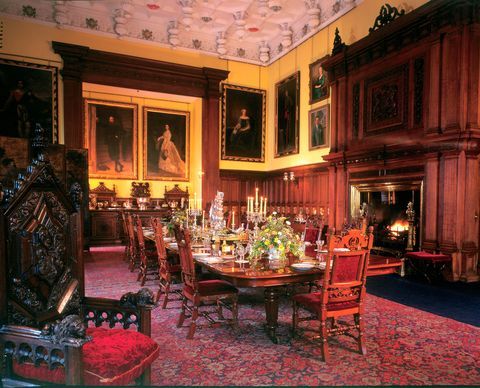


GLAMIS CASTLE -- one of the most recognisable castles in Scotland as it was the family home of Queen Elizabeth, the Queen Mother. It is set in the valley of Strathmore, near Forfar, county town of Angus, is an A-listed building and has been the seat of the Lyon family since the 14th Century, though the present building largely dates from the 17th Century. Its grounds are included on the Inventory of Gardens and Designed Landscapes in Scotland.
Needless to say the castle has its myths and ghosts. The castle contains a small chapel which accommodates 46 people but one of the seats is always reserved for the ghost of the beautiful Janet Douglas, Lady Glamis, whom the sadistic half-Tudor King, James V, had burnt at the stake on a trumped-up charge of witchcraft on the grounds of Edinburgh Castle -- and, for good measure, forced her husband to watch from a castle window the hideous spectacle of his wife burning to death. (King James of course was the father of the hapless Mary Queen of Scots who also met with a horrible death, albeit a far quicker one than that endured by poor Janet Douglas who, unlike Mary Stuart, was entirely innocent.
2 notes
·
View notes
Text
So I'm working on a Master's thesis on witchcraft in Scotland and I found a woman who shares my surname and was convicted as a witch (Janet Douglas, Lady Glamis) She was known to be a seer too 🤔🤔
43 notes
·
View notes
Photo





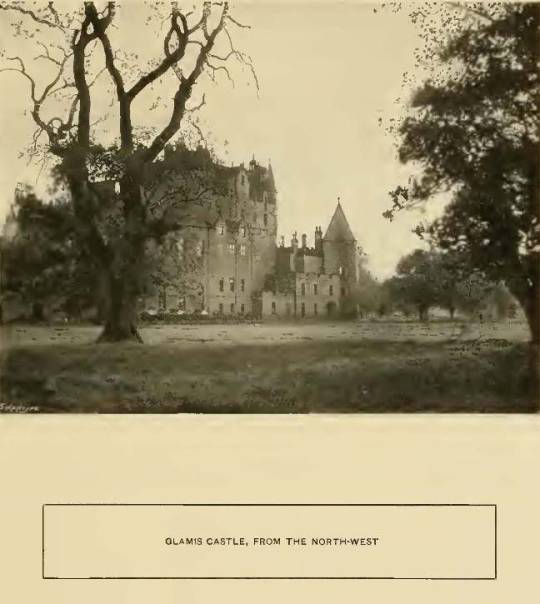




🏰 Glamis Castle (Angus, Scotland)
📜 Glamis Castle has been the ancestral seat to the Earls of Strathmore and Kinghorne since 1372 (it's known, the central part or Keep have been standing in 1016).
Glamis Castle is one of the most famous and beautiful castles in the United Kingdom, and is shrouded in mystery and many riddles.
👻 The most famous legend is that of the Monster of Glamis. The Monster was a very ugly disabled child who was kept hidden in the castle all his life. It is said that his rooms were bricked up after his death. A different version of the legend is that in every generation of the family, a vampire child is born. The vampire children are walled up in that room.
👻 The legend of the monster may have come from the true story of the Ogilvie family. Somewhere in the 16-foot-thick (4.9 m) walls is the famous room of skulls, where the Ogilvie family, who sought protection from their enemies the Lindsays, were walled up to die of starvation.
👻 There is a small chapel in the castle, with seating for 46 people. One seat in the chapel is always kept empty for a ghost called the "Grey Lady". The "Grey Lady" is thought to be Janet Douglas, Lady Glamis. No one is allowed to sit in that seat.
- -
🏰 Замок Глэмис (Ангус, Шотландия)
📜 Замок Глэмис был родовым местом графов Стратмора и Кингхорна с 1372 г. (известно, что центральная часть или Хранилище стояли в Глэмисе уже в 1016 г). В XV в. здание было значительно перестроено, добавлены башни, но самые большие изменения произошли в XVII-XVIII вв., когда замок перестали использовать как оборонительное сооружение.
Он является не только одним из самых красивых замков в Великобритании, но и окутан завесой тайн и множеством загадок.
👻 Самая известная легенда - история о монстре Глэмиса. Монстр был очень уродливым ребенком-инвалидом, которого всю жизнь прятали в замке. Говорят, что после его смерти его комнаты были замурованы кирпичом. Другая версия легенды гласит, что в каждом поколении семьи рождался ребенок-вампир. Дети вампиров замурованы в этой комнате.
👻 Легенда о Чудовище, возможно, пришла из подлинной истории семьи Огилви. Где-то в 5-метровых стенах находится знаменитая комната с черепами, где семья Огилви, искавшая защиты от своих врагов, была замурована в стену, и семья осталась умирать от голода.
👻 В замке есть небольшая часовня на 46 человек. Одно место в часовне всегда пустует для призрака под названием "Серая леди". Считается, что "Серая леди" - это Джанет Дуглас, леди Глэмис. Никому не разрешается сидеть на этом месте. Леди Джанет Дуглас, вдова лорда Глэмиса, была сожжена на костре как ведьма в 1540 г. Яковом V и ее дух бродит по замку.
#castle
#замок
#глэмис
#museum
#musee
#chateau
#Glamis
9 notes
·
View notes
Photo





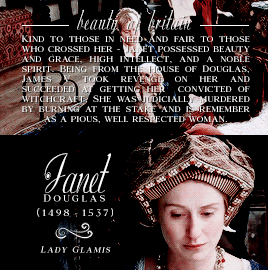

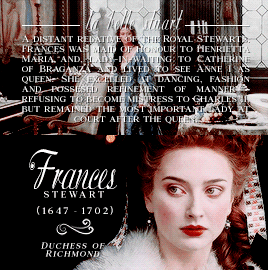

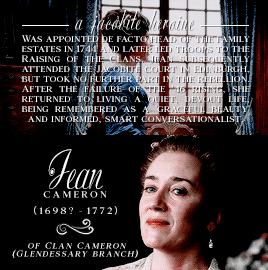
10 of our favourite ladies (excluding queens of Scotland)
#historyedit#scottish history#british history#noblewomen#clanswomen#princesses#gifs#ours#kingdom of scotland#p: matilda queen of england#p: margaret queen of norway#n: agnes randolph#p: margaret dauphine of france#p: eleanor archduchess of austria#n: janet douglas lady glamis#n: arbella stuart#n: frances stewart#p: louisa maria stuart#c: jean cameron of glendessary
254 notes
·
View notes
Photo
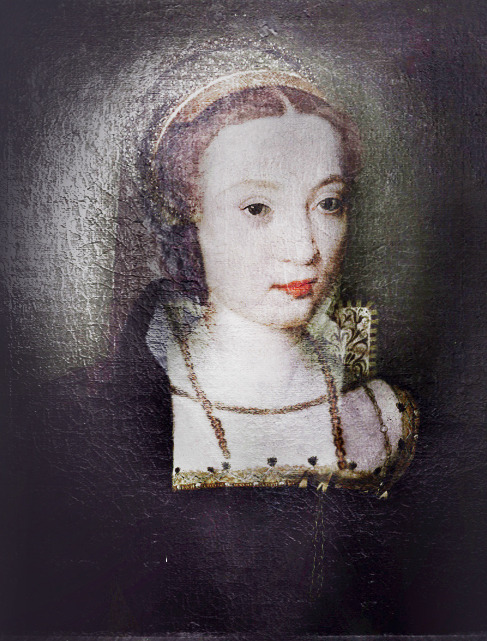


On July 17th 1537 Janet, Countess of Glamis was burnt at the stake on charges including Witchcraft and trying to poison the King.
Lady Janet Douglas was married to the 6th Lord of Glamis. It was a very advantageous marriage, and by all reports, also a very happy one. They had one son, John, and lived peacefully and in contentment until 1528, when Lord Glamis passed away. As was the way with well bred women in those days, Lady Janet married a second time, to a second son known as Archibald Campbell. Not much is known about their marriage.
King James V had a bone to pick with Lady Janet , well not actually her, but he had deep hatred he held for his own step-father who had held him captive in order to claim rulership – he was Lady Janet’s brother. So Janet was fair game for the vindictive King and if James couldn’t get revenge on Archibald Douglas, he’d get it on his sister instead.
James set to work on Janet’s downfall with a passion. He accused Lady Janet of making potions of ill intent with which to assassinate him, by the use of witchcraft. In doing so, he confiscated Glamis Castle in the name of the Crown and decided to live there. Lady Janet, her husband and her 16 year old son John were thrown in the dark and dank dungeons of Edinburgh Castle. On a side note, Archibald, Janet’s husband is said to have escaped the castle, but was later killed.
Nobody believed for a second that Lady Janet was guilty of the charges the King laid against her. She was a very well respected woman and was known to be good to those in need and fair to those who may have crossed her. The King therefore had trouble trying to convict her. There was only one way for his vengeance to be laid to rest… he would have to resort to torture.
So the King rounded up as many clansmen and servants as he could find, and put them on ‘the rack’, torturing them, after a short time they all ‘confessed’, claiming she was an evil witch who had it in for the King.
The final instrument of her undoing was when the King began on John, Janet’s 16 year old son. John had been forced to watch his friends, family and servants tortured and then became a victim of it himself. Of course there is only so much a human can deal with, physically and mentally, and poor John also confessed to witchcraft.
The King was euphoric! He had achieved is goal. With the evidence he had produced, both Lady Janet and her son John were convicted of Witchcraft and were sentenced to death.
On this day in 1537, Lady Janet was brought to the pyre for her execution. Eyewitnesses described her as a beautiful young woman who was in great suffering, which she endured with ‘man-like courage’. It was said that nobody ever doubted her innocence and that all knew her execution was purely in retaliation of King James’ hatred for her brother.
Lady Janet was burned alive at Castlehill in front of Edinburgh Castle . All of the onlookers watched in silence, tears in their eyes.
John, now the 7th Lord of Glamis, was not executed, and was released from prison after King James V died. Parliament also restored Glamis Castle back to him.
Lady Janet is said to roam the halls of Glamis Castle… she has been seen wandering the halls, kneeling in front of the alter praying in the chapel and above the clock tower.
Apparently, when in the chapel of the castle, people are overcome with a feeling of immense sadness and desolation. A seat is constantly kept empty for Lady Janet in the chapel, and it is said one hundred witnesses once saw her glide past them in the chapel, heading towards her allocated seat.
Lady Janet Douglas of Glamis is remembered as one of the most tragic figures in our history.
62 notes
·
View notes
Conversation
Which Woman From Sixteenth Century Scotland Should You Fight:
Isabella Hoppringle, Prioress of Coldstream: No.
Margaret Crichton, Countess of Rothes: No.
Janet Kennedy, Lady Bothwell: No.
Janet Campbell, Countess of Atholl: No.
Agnes Stewart, Countess of Bothwell: No.
Margaret Tudor, Queen of Scots: No.
Janet Douglas, Lady Glamis: No.
Katherine Stewart, Countess of Morton: No.
Euphemia Leslie, Prioress of Elcho: No.
Isobel Hoppar: No.
Margaret Stewart, Lady Gordon: No.
Elizabeth Campbell, Countess of Moray: No.
Elizabeth Keith, Countess of Huntly: No.
Margaret Douglas, Countess of Lennox: No.
Agnes Campbell, wife of MacDonald of Dunyvaig: No.
Marion Ogilvy: No.
Mary of Guise, Queen of Scots: No.
Marie Pieris, Lady Seton: No.
Janet Stewart, Lady Fleming: No.
Margaret Erskine, Lady of Lochleven: No.
Mariota Haliburton, Lady Hume: No.
Janet Beaton, Lady of Branxholme and Buccleugh: No.
Margaret Douglas, Countess of Arran: No.
Agnes Keith, Countess of Moray: No.
Agnes Leslie, Countess of Morton: No.
Jean Gordon, Countess of Bothwell/Sutherland: No.
Anne Hamilton, Countess of Huntly: No.
Annabella Murray, Countess of Mar: No.
Katherine Ruthven, Lady of Glenorchy: No.
Jean Stewart, Countess of Argyll: No.
Fionnghuala MacDonald, wife of the king of Tyrconnel: No.
Anne of Denmark, Queen of Scots: No.
Margaret Winstar, Lady of Logie: No.
Elizabeth Stewart, Countess of Arran: No...
26 notes
·
View notes
Text
Desecrate portraits
Okay, so some of you probably know that when I write I sometimes gather pictures for inspiration--these are the ones from this story. A lot of them ended up being future!pics, which is fun because I always like getting a peek into what will happen to characters
First Edward, in about 1510, right before he became a priest:

then about 20 years after our story:

Honestly, I don’t like the first one very much, but I had a horrible time finding a remotely decent, non-freakish-looking young man portrait. O_o I do like the second one though.
Anyway, here’s Bella when our story begins:
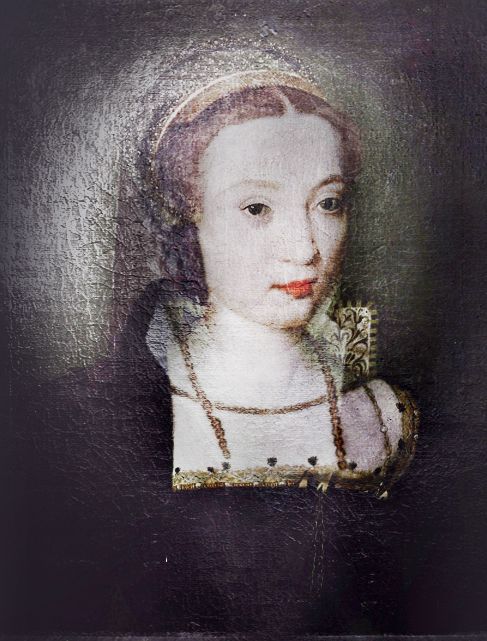
We’re going to ignore the ermine, as that’s not something a young lady of her rank would have worn. It’s just spots on the canvas. That’s all. ;)
And here’s their daughter (who was not named Renesmee--that’s a bad enough name now; it certainly wouldn’t have existed then!) They named her Alice, after their friend who facilitated their relationship, and they call her Little Alice.

We can tell she’s getting a good education because she’s holding some sort of astronomical instrument. Little Alice won’t appreciate being called “little” for long... Frankly, her clothes are fancier/more costly than they should be, but oh well. I liked her face. :)
I couldn’t find a circa 1515 picture of Carles/Carlisle that I liked, but here’s one of him about 20 years later:
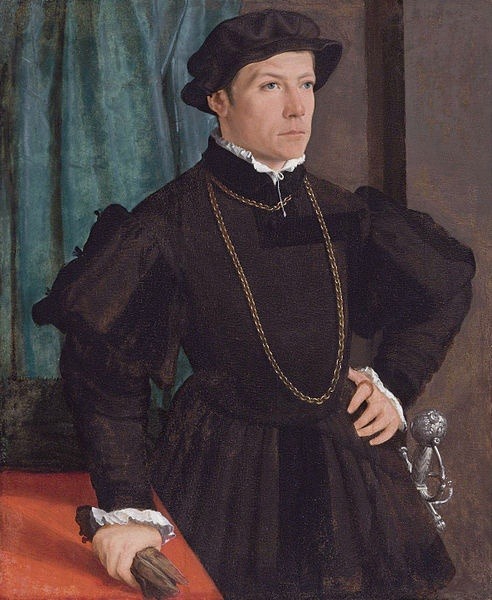
And here’s Emme/Esme, in about 1525:
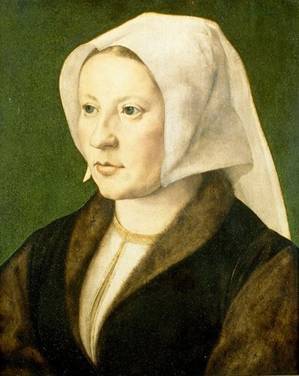
She and Carles were childless for a number of years, and had given up hoping when she became pregnant.
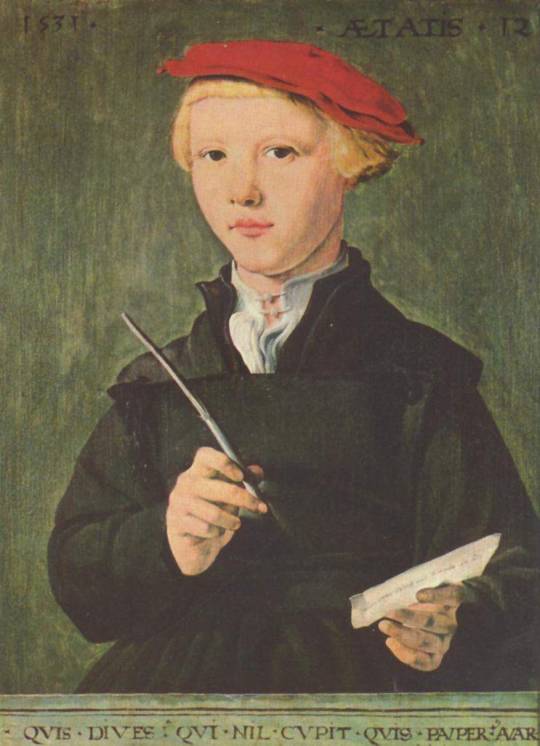
They had a son and named him Carles after his father, and for a brief time (before Alice wouldn’t tolerate it any longer) there was a Little Alice and a Little Carles running around the Cullen estate.
I had a horrible time finding period appropriate portraits of Emmet/Emmett and Rose/Rosalie. So have a non-period appropriate one that made me think of them:

And here’s a vastly wrong one from a historical fashion point of view, but I adore it for Rose and Ned:

And there’s another little Masson/Masen on the way. :D
Going to put all the portrait titles/subjects/artists below if you’re interested. Hope you enjoyed this peek into the characters and future of Desecrate!
Portraits in order:
1. A Man, ca. 1510, attributed to Franciabigio
2. Portrait of a Young Englishman, ca. 1540, Titian
3. Janet Douglas, Lady Glamis; ca. 1515
4. A Young Girl with Astronomical Instrument, ca. 1520, Jan Gossaert
5. Johann Jakob Fugger, ca. 1541, Christoph Amberger
6. Isabella of of Austria, ca. 1525, Jan Gossaert
7. 1531, Jan van Scorel
#my writing#Desecrate#Twilight fanfiction#Edward Masen#Edward Cullen#Bella Swan#Carlisle Cullen#Esme Cullen#Emmett Cullen#Rosalie Hale
12 notes
·
View notes
Photo

Glamis Castle, one of the most haunted castles in Great Britain, was the talk of Europe during the second half of the 19th century. The first ghost that was said to haunt the castle corridors was that of Lady Janet Douglas. Caught up in regional politics, Lady Janet was accused of poisoning her husband (the 6th Lord of Glamis) and ultimately was convicted of witchcraft in 1537. She was burned at the stake in Edinburgh. The spirit of Lady Janet is said to favor the castle’s clock tower. Yet the most famous legend of Glamis Castle is that of an unknown prisoner, often referred to as a monster, held in a secret hidden chamber . The Monster of Glamis has been described as deformed, hairy, ‘a human toad,’ and always terrifying to behold. www.deadlive.co.uk #deadlive #deadliveevents #psychicreadings #ghosthunts #hauntedvenues #ghosthunting #spookynights #psychicevents #ghosthuntingequipment #psychicnights #hauntedhouse #hauntedinn #hauntedpubs #hauntednights #northwestghosthunts #hauntedcastles #hauntedhalls #ghostscaughtoncamera #spookyevents #hauntedengland #liverpoolghosthunts #tarotreaders #mediumship https://www.instagram.com/p/CCBLkQ7lYzL/?igshid=1fxye4sshev3t
#deadlive#deadliveevents#psychicreadings#ghosthunts#hauntedvenues#ghosthunting#spookynights#psychicevents#ghosthuntingequipment#psychicnights#hauntedhouse#hauntedinn#hauntedpubs#hauntednights#northwestghosthunts#hauntedcastles#hauntedhalls#ghostscaughtoncamera#spookyevents#hauntedengland#liverpoolghosthunts#tarotreaders#mediumship
0 notes
Photo


Drawing ✏️ Glamis Castle
Considered as the most haunted castle in Scotland. There are many ghosts there, among them: Lady Janet Douglas, accused of witchcraft, she was tortured and then burned in Edinburgh in 1537. She would still live in the form of Gray Lady it is claimed that a seat is always reserved for the gray lady at the little chapel of the castle. Home to many monsters, the count of Crawford who would have lost his soul after a game of cards with the Devil and the monster of Glamis, child born deformed and locked up all his life in the castle until he died there. An alternative version of the legend would be that a vampire is born each generation and is kept inside the walls of these rooms. A place so bloody that it inspired the great Shakespeare himself. Part of the plot of his legendary Macbeth takes place at Glamis Castle. There are many legends of monsters of ghosts and secrets lodged inside these stones of rivers which served to constitute this abyss of terror.
Illustration by Lysa Karell
www.lysakarell.com
#drawing#graphitepencil#edinburgh#scotland#legend#witchcraft#vampire#shakespeare#macbeth#illustration#lady#castle#art#artist#blackandgrey#witch#creepydrawing#creepy#horror#darknes#fantasy#artwork#work#pencilart#ghost
0 notes
Text
True Ghost Stories from the Most Haunted Places in the World
True Ghost Stories from the Most Haunted Places in the World
Glamis Castle, Scotland

MagSpace/Shutterstock
This castle was first built in the 14th century, and it’s where the Queen Mother—the late mother to Queen Elizabeth II—grew up. It’s also said to be populated by a bevy of ghosts including the Grey Lady, or the Lady of Glamis, otherwise known as Lady Janet Douglas. Accused of murdering her husband by poisoning him and of using witchcraft to…
View On WordPress
0 notes